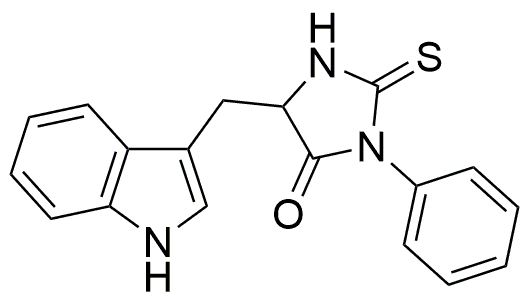Phenylthiohydantoin-tryptophan is widely utilized in research focused on:
- Protein Sequencing: This compound is essential in the Edman degradation method for sequencing proteins, allowing researchers to determine amino acid sequences accurately.
- Biochemical Assays: It serves as a reagent in various biochemical assays, facilitating the detection and quantification of proteins and peptides in complex mixtures.
- Drug Development: In pharmaceutical research, it aids in the design of new drugs by providing insights into protein interactions and stability, which is crucial for developing effective therapeutics.
- Diagnostic Applications: The compound is used in diagnostic tests to identify specific proteins related to diseases, helping in early detection and treatment strategies.
- Research on Tryptophan Metabolism: It plays a role in studies investigating tryptophan metabolism, which is important for understanding various physiological and psychological conditions.
General Information
Properties
Safety and Regulations
Applications
Phenylthiohydantoin-tryptophan is widely utilized in research focused on:
- Protein Sequencing: This compound is essential in the Edman degradation method for sequencing proteins, allowing researchers to determine amino acid sequences accurately.
- Biochemical Assays: It serves as a reagent in various biochemical assays, facilitating the detection and quantification of proteins and peptides in complex mixtures.
- Drug Development: In pharmaceutical research, it aids in the design of new drugs by providing insights into protein interactions and stability, which is crucial for developing effective therapeutics.
- Diagnostic Applications: The compound is used in diagnostic tests to identify specific proteins related to diseases, helping in early detection and treatment strategies.
- Research on Tryptophan Metabolism: It plays a role in studies investigating tryptophan metabolism, which is important for understanding various physiological and psychological conditions.
Documents
Safety Data Sheets (SDS)
The SDS provides comprehensive safety information on handling, storage, and disposal of the product.
Product Specification (PS)
The PS provides a comprehensive breakdown of the product’s properties, including chemical composition, physical state, purity, and storage requirements. It also details acceptable quality ranges and the product's intended applications.
Certificates of Analysis (COA)
Search for Certificates of Analysis (COA) by entering the products Lot Number. Lot and Batch Numbers can be found on a product’s label following the words ‘Lot’ or ‘Batch’.
*Catalog Number
*Lot Number
Certificates Of Origin (COO)
This COO confirms the country where the product was manufactured, and also details the materials and components used in it and whether it is derived from natural, synthetic, or other specific sources. This certificate may be required for customs, trade, and regulatory compliance.
*Catalog Number
*Lot Number
Safety Data Sheets (SDS)
The SDS provides comprehensive safety information on handling, storage, and disposal of the product.
DownloadProduct Specification (PS)
The PS provides a comprehensive breakdown of the product’s properties, including chemical composition, physical state, purity, and storage requirements. It also details acceptable quality ranges and the product's intended applications.
DownloadCertificates of Analysis (COA)
Search for Certificates of Analysis (COA) by entering the products Lot Number. Lot and Batch Numbers can be found on a product’s label following the words ‘Lot’ or ‘Batch’.
*Catalog Number
*Lot Number
Certificates Of Origin (COO)
This COO confirms the country where the product was manufactured, and also details the materials and components used in it and whether it is derived from natural, synthetic, or other specific sources. This certificate may be required for customs, trade, and regulatory compliance.


